India’s Shubhanshu Shukla Blasts Off with Axiom Mission 4

On June 25, 2025, at precisely 2:31 a.m. Eastern Daylight Time (1131 IST), the world watched in awe as Axiom Mission 4 (Ax-4) was launched into space from the Kennedy Space Center in Florida. The mission was propelled by SpaceX’s reliable Falcon 9 rocket, marking the beginning of a 14-day voyage to the International Space Station.
This launch is more than just another step in human spaceflight; it is a milestone in international collaboration, with astronauts representing the United States, India, Poland, and Hungary onboard. The Crew Dragon spacecraft is set to dock with the ISS on June 26 at around 13:00 UTC, which is approximately 4:30 p.m. Indian Standard Time. The launch was smooth and the rocket performed flawlessly, showcasing the maturity and reliability of commercial space transportation systems.
India’s Triumphant Return to Human Spaceflight
One of the most significant aspects of this mission is the return of India to human space exploration after a long gap of 41 years. Wing Commander Shubhanshu Shukla of the Indian Air Force has made history by becoming the second Indian to go into space and the first to visit the International Space Station. The last Indian to fly into space was Rakesh Sharma in 1984 aboard the Soviet Soyuz T-11 spacecraft.
Shukla’s journey has ignited a new wave of inspiration across India, as he carries not just scientific payloads but also the hopes and dreams of more than a billion citizens. His presence on this mission was made possible through a strategic government decision and a partnership with Axiom Space, for which the Indian government reportedly invested approximately ₹550 crore. This investment covers astronaut training, research support, and mission participation, and it is expected to yield valuable operational knowledge for India’s upcoming Gaganyaan mission.
A Team of Astronauts Reflecting Global Unity
The Axiom Mission 4 crew represents the growing diversity of spacefarers in the modern era. Commanding the mission is Peggy Whitson, a decorated former NASA astronaut from the United States who holds the American record for cumulative time in space. Alongside her, Shubhanshu Shukla represents India as the mission pilot.
The mission also includes Slawosz Uznański-Wiśniewski from Poland, a European Space Agency reserve astronaut, and Tibor Kapu from Hungary, an aerospace engineer making history for his country as its second astronaut since 1980. This is the first time astronauts from India, Hungary, and Poland have flown together on a single mission, demonstrating how spaceflight is increasingly becoming a truly global endeavor. Hungary funded its astronaut’s seat through its “Hungarian to Orbit” program, while Poland’s participation was facilitated via the European Space Agency. These national investments signify a broader geopolitical commitment to joining the international space community.
Science at the Heart of the Mission
The Ax-4 mission is poised to carry out over 60 scientific experiments in collaboration with 31 countries, making it the most experiment-rich private mission to the ISS to date. Each astronaut on board is tasked with conducting research in a range of fields, from biology and physiology to materials science and artificial intelligence. India’s contribution is significant. Shukla will be conducting seven major experiments developed in coordination with Indian research institutions.
One of the key experiments focuses on understanding how fenugreek and mung bean seeds germinate in microgravity, a study that could have implications for future space agriculture and sustainability during long-duration missions. Another set of experiments will observe physiological responses in space conditions, contributing to the Gaganyaan mission’s planning and astronaut health protocols. Additionally, India has also sent up a prototype of an AI-based virtual assistant to test interaction models under isolated and zero-gravity conditions.
Hungary’s experiments will examine how biological cells respond to radiation and microgravity, while Poland’s payloads include behavioral studies and microbial growth analysis. Collectively, these experiments are expected to yield critical data for future long-duration missions to the Moon, Mars, and beyond.
A Year of Intense Training and Global Preparation
The Ax-4 astronauts underwent a rigorous and comprehensive training program for nearly a year, reflecting the complexity and responsibility of the mission. Their preparation spanned multiple global facilities. In the United States, they trained extensively at NASA’s Johnson Space Center in Houston to simulate life aboard the ISS and learn spacecraft operations. In Europe, they visited the European Space Agency’s Astronaut Centre in Cologne for international systems integration.
Specific spacecraft training was carried out with SpaceX teams to understand the intricacies of the Crew Dragon vehicle. Shukla’s backup astronaut, Group Captain Prashanth Balakrishnan Nair, was also part of the training cohort, ensuring India has an experienced crew pool for its future Gaganyaan mission. The training not only focused on scientific knowledge and mechanical skills but also emphasized psychological endurance, teamwork under pressure, and emergency preparedness. The comprehensive preparation reinforces the high standards expected of astronauts in commercial and national space missions alike.
From Delay to Liftoff: A Mission That Overcame Challenges
Originally planned for May 29, the Ax-4 mission faced several delays before liftoff. The first delay occurred due to a minor leak in the Falcon 9’s upper-stage liquid oxygen valve, which engineers identified and fixed after a few days of inspection. Subsequent rescheduling was required because of weather concerns at the oceanic recovery zone—an essential part of the mission’s safety plan.
Further checks on the docking mechanism between the Crew Dragon capsule and the ISS also contributed to the postponement. The delays, while frustrating, reflected the rigorous safety and operational standards that define today’s human spaceflight. After resolving all concerns, Axiom and SpaceX teams cleared the mission for launch. When the countdown finally reached zero, the rocket soared into the early morning sky, a brilliant streak of light and engineering precision.
Axiom Space’s Long-Term Vision for Commercial Orbiting Platforms
Axiom Mission 4 is not an isolated event but a stepping stone toward a much grander vision. Axiom Space, the mission organizer, is planning to construct the world’s first commercial space station. This station will initially attach to the ISS and will later separate to function independently. Axiom’s modular station will provide laboratories, astronaut habitats, and even space tourism facilities.
Construction is expected to begin with the launch of the first module in late 2026. Over time, Axiom’s modules will form a fully autonomous station that replaces the ISS when it is decommissioned in the 2030s. Previous missions by Axiom, such as Ax-1, Ax-2, and Ax-3, have progressively built the foundation for this vision. Ax-4 is yet another crucial demonstration that commercial spaceflight can contribute to humanity’s orbital ambitions with scientific depth and international participation.
India’s Space Diplomacy and Global Presence
Shubhanshu Shukla’s participation in this international mission represents more than a technological feat—it is a triumph of India’s growing soft power in space diplomacy. With this flight, India joins the league of nations actively shaping the next era of global space collaboration. It also strengthens India’s space ties with the United States, European Union, and private companies like Axiom and SpaceX. There are reports suggesting that Indian Prime Minister Narendra Modi may establish a live video link with Shukla while he is aboard the ISS. If this happens, it would not only be a symbolic moment but a strong diplomatic gesture that underscores India’s commitment to space as a domain of peace, science, and partnership. The mission is likely to influence future bilateral and multilateral agreements related to space exploration, payload sharing, and astronaut training.
Looking Ahead: What the Future Holds
As the Crew Dragon capsule continues its journey toward the International Space Station, mission controllers and scientific teams on Earth are preparing for the research phase to begin in full swing once the docking is complete. Over the course of the next two weeks, the astronauts will operate continuously to ensure that all planned scientific activities are completed successfully. After the mission ends, the capsule will return to Earth with a splashdown in the Atlantic Ocean off the coast of Florida.
For India, this mission provides invaluable insights for the Gaganyaan programme, which is now targeting a human flight window in 2027. Meanwhile, Axiom Space will continue developing its orbital modules, and SpaceX is expected to transition from Crew Dragon to its next-generation Starship system for future lunar and interplanetary missions.
A New Era Begins for Global Spaceflight
Axiom Mission 4 stands as a powerful symbol of what the future of spaceflight can be—cooperative, inclusive, and driven by science. For India, it is a moment of pride, marking its return to human spaceflight with an eye firmly on the future. For the world, it demonstrates that commercial partnerships, shared scientific goals, and a united human spirit can unlock the next great chapter in our journey beyond Earth. As Shubhanshu Shukla orbits above, he is not only observing the Earth from the stars but also helping humanity reach new heights together.







